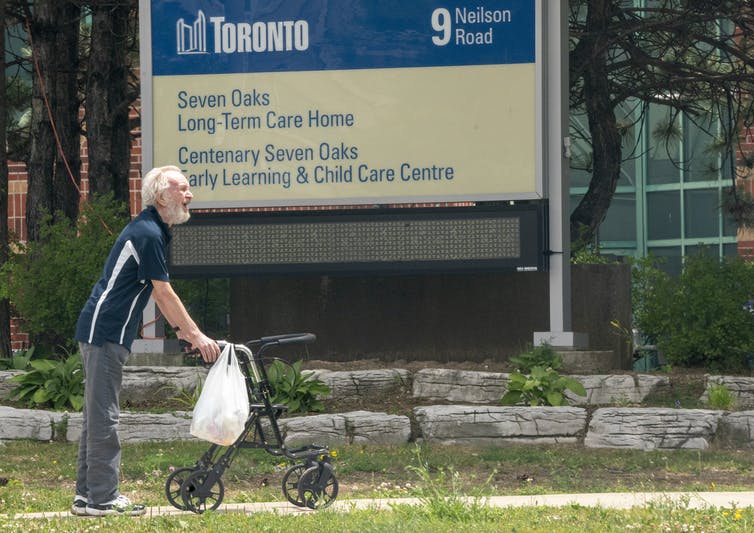
In the wake of the COVID-19 pandemic, there’s a once-in-a-generation opportunity to correct how public funds will be allocated for long-term care in Ontario. The choice is between more profits for shareholders or reinvestment in care for seniors and improved working conditions for employees.
Ownership in Ontario’s publicly funded long-term care is currently split between two types of providers.
First, there are for-profit facilities, owned largely by real estate companies that hold and/or manage licences to provide care. My research has found that currently, 60.1 per cent of the beds are owned or managed by for-profits. This group is a mixture of public corporate chains, real estate investment trusts and private equity firms. Six in 10 people who live in long-term care in this province do so under a profit-taking model.
The second group are care homes that happen to own real estate and reinvest surplus back into the home. Nearly four of 10 bed licences (39.9 per cent) are owned by this group. The latter are typically called not-for-profit, although they may also be publicly owned.
Even before the pandemic, for-profit facilities were associated with significantly higher rates of mortality and hospital admission, suggesting there’s significantly worse quality of care overall in for-profit than in non-profit and public homes.
In addition, the devastation in long-term care during the height of the pandemic’s first and second waves happened mostly in for-profits, where a higher proportion of residents died. There was a 25 per cent higher risk of death from COVID-19 in for-profit facilities.

THE CANADIAN PRESS/Nathan Denette
Renegotiating licences
The Ontario government is currently approving licences with operators for up to 30 years. About one-third of the existing bed licences (26,531 beds) in 257 long-term care homes will expire by June 30, 2025. These licenses are in various stages of being renegotiated for the next 30 years.
The current government also announced there will be 30,000 new beds and 28,000 upgraded beds in place by 2028, also at various stages of approval. With the renewals, renovations and construction, what happens to long-term care licences in the next calendar year will shape the course of long-term care for the next 30 years.
A vote in this election therefore represents a choice between more for-profits or a move towards non-profit long-term care.
Read more:
Canadians want home care, not long-term care facilities, after COVID-19
Long-term care licences can be very lucrative. Each new bed built is eligible for a construction funding subsidy, known as a CFS, calculated per day. The CFS ranges from $20.53 to $23.78 per day depending on where the home is located; large urban settings have higher subsidies. This is in addition to the funding an operator receives from government to provide care and food.
If a home has 160 beds, an additional 75 cents per bed per day is added to the subsidy. In the most expensive urban market with 160 beds (five units of 32 people), tax dollars will fund that organization $3,924.80 per day in capital costs to a maximum of $51,376 per bed — or a subsidy for the building of $8,220,160.
These subsidies are meant to cover between 10 to 17 per cent of capital costs. Rural beds are capped at a maximum subsidy of $29,246 per bed annually, while large urban centres cap at $51,376 per bed.
There are no upper limits on bed numbers, so it’s difficult to calculate the maximum subsidy. There are few homes in the province exceeding 160 beds, but that could change. The public doesn’t have a stake in the ownership of a home due to the subsidies.
Accommodation fees
Facilities also collect and retain rental accommodation fees from residents. For semi-private, shared nursing home rooms, a resident will pay $2,280.61 monthly at current rates, and for a private room, residents are charged up to $2,701.61 per month. Those living in for-profit retirement homes, many of whom are on waiting lists for a long-term care bed, are not included in this model.
If 60 per cent of the rooms are private and not shared, and assuming current accommodation rates, my calculations show the home will collect and retain $116,719,810 in accommodation fees over the 30-year licence, or nearly $4 million per year.
These funds collected for accommodation rental are completely separate from the funds publicly paid to support care, currently set at $187.73 per day for a home operating at 100 per cent based on the complexity of the needs of its residents.
If the current government or any successive government replicates past decisions, more than 65,000 Ontarians a year will live in a for-profit facility — many run by corporations focused on their real estate investments — in the next decade. If we follow a different path, these subsidies could fund operators that are primarily care organizations and where real estate holdings support the care, not the other way around.

THE CANADIAN PRESS/Frank Gunn
No one should assume they or their loved ones won’t need long-term care. All modern and caring societies have long-term care. The difference is that in countries like Norway, the focus is on high-quality, publicly delivered care, not on favouring for-profit real estate models.
Certainly not everyone will need long-term care. Not everyone needs open-heart surgery. But we do need high-quality public health care so that no one has to contemplate losing their life savings to survive. Those who need long-term care are among society’s most vulnerable members, and they deserve the very best quality of care and for every dollar to be invested in ensuring their care is top-notch.
No further study of this issue is required. Those living in for-profit facilities fare worse than those in non-profits and public homes.
In Ontario, we can prioritize people over profits by casting our ballots for those committed to transforming long-term care into a non-profit model focused on high-quality care. Know which party supports non-profit, long-term care and vote accordingly.
![]()
Tamara Daly receives funding from the Canadian Institutes of Health Research and Social Sciences and Humanities Research Council























